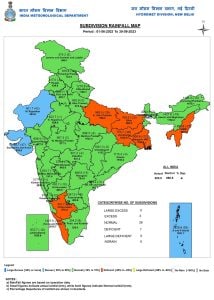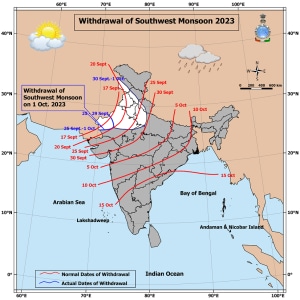Southwest monsoon 2023 bids adieu to northwest parts of the country, including the national capital Delhi, on 1 October; however, as per the India Meteorological Department’s seasonal criteria, the monsoon ends on 30 September as it lasts from 1 June to 30 September irrespective of the actual date of advancement or withdrawal. The rainfall figures from 1 October are registered in a different season, which is called the post-monsoon season, or better known as the northeast monsoon season. Some key highlights of this season: • Rainfall over the country as a whole during monsoon season (June-September), 2023, was 94 per cent of its long period average (LPA). • Seasonal rainfalls over northwest India, central India, southern peninsula and northeast India were 101 per cent, 100 per cent, 92 per cent and 82 per cent of respective LPA. • The southwest monsoon seasonal (June to September) rainfall over the the monsoon core zone, which consists of most of the rainfed agriculture regions in the country received 101 per cent of LPA and thus was normal (94 per cent to 106 per cent of LPA). • Out of the total 36 meteorological subdivisions, 3 subdivisions constituting 9 per cent of the total area of the country received excess rainfall, 26 subdivisions received normal rainfall (73 per cent of the total area) and 7 subdivisions (18 per cent of the total area) received deficient season rainfall. The 7 meteorological subdivisions which got deficient rainfall are Nagaland, Manipur, Mizoram and Tripura (NMMT), Gangetic West Bengal, Jharkhand, Bihar, East UP, South interior Karnataka and Kerala. • Monthly rainfall over the country as a whole was 91 per cent of LPA in June, 113 per cent of LPA in July, 64 per cent of LPA in August, and 113 per cent of LPA in September. • Southwest monsoon currents advanced to the south Andaman Sea and Nicobar Islands on time (on 19th May, three days ahead of its normal date). However, further advance thereafter was sluggish. It set in over Kerala on 8 June, seven days behind the normal date and covered the entire country by 2 July, six days ahead of the normal date. Monsoon withdrawal commenced from west Rajasthan on 25 September (with a delay of eight days). • This monsoon had an August that saw a rainfall deficit of 36 per cent. A good September that gave us 13 per cent above normal rainfall and made up the August deficit somewhat, but India still ended this monsoon with one of the 30 lowest monsoon rainfall since 1901. • Mawsynram (Cherrapunji) with 8875 mm reported the highest rainfall in the country during the four month season. [caption id=“attachment_13193332” align=“alignnone” width=“577”] Monsoon 2023 rainfall statistics for different regions of India across months[/caption] How does the national capital Delhi perform this season? Delhi Safdarjung recorded 660.8 mm rain this monsoon season, out of this 70 per cent of rain occurred in just seven days. For the 1st time in the last 13 years, both August and September simultaneously recorded less than 100 mm of rain. Number of days with rainfall greater than 100 mm = 2 days Number of rainy days in June = 8 days Number of rainy days in July = 10 days Number of rainy days in August = 3 days Number of rainy days in September = 5 days Note: Rainy days are considered when single day rainfall is equal to or above 2.5 mm. Subdivision-wise seasonal rainfall figures: During the entire monsoon India wide rainfall stands at an actual of 820.0 mm against the normal of 868.8 mm, the departure from normal stands at -5.6 per cent. Subdivision-wise seasonal rainfall in the period from 1 June to 30 September, 2023: • Southern peninsula: Actual 659.0 mm against the average of 716.2 mm, -8 per cent departure from normal. • East and northeast India: Actual 1115.0 mm against the average of 1367.3mm, -18.5 per cent departure from normal. • Northwest India: Actual 593.0 mm against the average of 587.6 mm, +0.9 per cent departure from normal. • Central India: Actual 981.7 mm against the average of 978.0 mm, +0.4 per cent departure from normal. [caption id=“attachment_13193382” align=“alignnone” width=“496”]
 Subdivision-wise seasonal rainfall over India during the entire monsoon season[/caption] Current synoptic weather features influencing weather in India as on 1 October 2023: The well marked low pressure area over south Madhya Maharashtra and neighbourhood with the associated cyclonic circulation extending up to 7.6 km above mean sea level persists. It is very likely to move further north-eastwards and weaken into a low pressure area during the next 12 hours. The well marked low pressure area over western parts of Gangetic West Bengal and adjoining Jharkhand with the associated cyclonic circulation extending up to 7.6 km above mean sea level persists. It is likely to move further north-westwards slowly during the next 24 hours. A trough from the cyclonic circulation associated with the above well-marked low-pressure area over western parts of Gangetic West Bengal, adjoining Jharkhand, and east Uttar Pradesh at 0.9 km above mean sea level persists. Current status of Monsoon withdrawal • The line of withdrawal of southwest monsoon continues to pass through Gulmarg, Dharamshala, Pantnagar, Etawah, Morena, Sawai Madhopur, Jodhpur, Barmer and 25.7°N/70.3°E. • Conditions are becoming favourable for further withdrawal of southwest monsoon from remaining parts of Jammu-Kashmir-Ladakh-Gilgit-Baltistan-Muzaffarabad, Himachal Pradesh, Uttarakhand and West Uttar Pradesh; some more parts of West Madhya Pradesh; remaining parts of Rajasthan and some parts of Gujarat state during next 2-3 days. [caption id=“attachment_13193402” align=“alignnone” width=“770”]
Subdivision-wise seasonal rainfall over India during the entire monsoon season[/caption] Current synoptic weather features influencing weather in India as on 1 October 2023: The well marked low pressure area over south Madhya Maharashtra and neighbourhood with the associated cyclonic circulation extending up to 7.6 km above mean sea level persists. It is very likely to move further north-eastwards and weaken into a low pressure area during the next 12 hours. The well marked low pressure area over western parts of Gangetic West Bengal and adjoining Jharkhand with the associated cyclonic circulation extending up to 7.6 km above mean sea level persists. It is likely to move further north-westwards slowly during the next 24 hours. A trough from the cyclonic circulation associated with the above well-marked low-pressure area over western parts of Gangetic West Bengal, adjoining Jharkhand, and east Uttar Pradesh at 0.9 km above mean sea level persists. Current status of Monsoon withdrawal • The line of withdrawal of southwest monsoon continues to pass through Gulmarg, Dharamshala, Pantnagar, Etawah, Morena, Sawai Madhopur, Jodhpur, Barmer and 25.7°N/70.3°E. • Conditions are becoming favourable for further withdrawal of southwest monsoon from remaining parts of Jammu-Kashmir-Ladakh-Gilgit-Baltistan-Muzaffarabad, Himachal Pradesh, Uttarakhand and West Uttar Pradesh; some more parts of West Madhya Pradesh; remaining parts of Rajasthan and some parts of Gujarat state during next 2-3 days. [caption id=“attachment_13193402” align=“alignnone” width=“770”] Current status of Monsoon withdrawal over India as on 1 October 2023[/caption] All India weather forecast till 8 October 2023: The anti-cyclonic circulation over Pakistan and adjoining western Rajasthan will strengthen further, and dry winds will start engulfing the deep interiors of India. As a result, dry weather conditions will start over various parts of west and central India, resulting in the withdrawal of monsoons up to Gujarat, Maharashtra, Madhya Pradesh, and Uttar Pradesh by 7-8 October. Sunny weather will lead to a rise in daytime temperatures; however, weather from sunsets to sunrises will become pleasant as the minimum temperature should be falling near 20°C or even below at a few places in Punjab, Haryana, Delhi NCR, Uttar Pradesh, Gujarat, Madhya Pradesh, and Chhattisgarh. A well-marked low-pressure area over Jharkhand will keep monsoon rains active across east India and north-east India. Moderate to heavy rains are expected in East Uttar Pradesh, Bihar, Jharkhand, West Bengal, Chhattisgarh, Odisha, Sikkim, Arunachal Pradesh, Assam, Meghalaya, Mizoram, Manipur, Nagaland, and Tripura from 2 October to 5 October, with periodic spells of very heavy rains. The spread of showers will gradually decrease after 5 October, leading to a transition towards monsoon withdrawal in this region as well. The southern peninsula experienced a very active south-west monsoon this year, especially around Tamil Nadu, Telangana, and Andhra Pradesh; however, Karnataka and Kerala had one of the worst monsoons ever. In the upcoming week, rains are expected to decrease significantly across the states in south India, with almost dry weather conditions reaching up to parts of Telangana and Goa. Revival of rains in Kerala, Tamil Nadu, and the south interiors of Karnataka is expected around 10 October, when thunderstorms will resume again for the interiors around Bangalore and pre-northeast monsoon showers will commence over the coastal areas around Chennai. The writer, better known as the Rohtak Weatherman, interprets and explains complex weather patterns. His impact-based forecasts @navdeepdahiya55 are very popular in north India. Views expressed in the above piece are personal and solely that of the author. They do not necessarily reflect Firstpost_’s views._ Read all the
Latest News ,
Trending News ,
Cricket News ,
Bollywood News , India News and
Entertainment News here. Follow us on
Facebook,
Twitter and
Instagram.
Current status of Monsoon withdrawal over India as on 1 October 2023[/caption] All India weather forecast till 8 October 2023: The anti-cyclonic circulation over Pakistan and adjoining western Rajasthan will strengthen further, and dry winds will start engulfing the deep interiors of India. As a result, dry weather conditions will start over various parts of west and central India, resulting in the withdrawal of monsoons up to Gujarat, Maharashtra, Madhya Pradesh, and Uttar Pradesh by 7-8 October. Sunny weather will lead to a rise in daytime temperatures; however, weather from sunsets to sunrises will become pleasant as the minimum temperature should be falling near 20°C or even below at a few places in Punjab, Haryana, Delhi NCR, Uttar Pradesh, Gujarat, Madhya Pradesh, and Chhattisgarh. A well-marked low-pressure area over Jharkhand will keep monsoon rains active across east India and north-east India. Moderate to heavy rains are expected in East Uttar Pradesh, Bihar, Jharkhand, West Bengal, Chhattisgarh, Odisha, Sikkim, Arunachal Pradesh, Assam, Meghalaya, Mizoram, Manipur, Nagaland, and Tripura from 2 October to 5 October, with periodic spells of very heavy rains. The spread of showers will gradually decrease after 5 October, leading to a transition towards monsoon withdrawal in this region as well. The southern peninsula experienced a very active south-west monsoon this year, especially around Tamil Nadu, Telangana, and Andhra Pradesh; however, Karnataka and Kerala had one of the worst monsoons ever. In the upcoming week, rains are expected to decrease significantly across the states in south India, with almost dry weather conditions reaching up to parts of Telangana and Goa. Revival of rains in Kerala, Tamil Nadu, and the south interiors of Karnataka is expected around 10 October, when thunderstorms will resume again for the interiors around Bangalore and pre-northeast monsoon showers will commence over the coastal areas around Chennai. The writer, better known as the Rohtak Weatherman, interprets and explains complex weather patterns. His impact-based forecasts @navdeepdahiya55 are very popular in north India. Views expressed in the above piece are personal and solely that of the author. They do not necessarily reflect Firstpost_’s views._ Read all the
Latest News ,
Trending News ,
Cricket News ,
Bollywood News , India News and
Entertainment News here. Follow us on
Facebook,
Twitter and
Instagram.
Revival of rains in Kerala, Tamil Nadu, and the south interiors of Karnataka is expected around 10 October
Advertisement
End of Article


)

)
)
)
)
)
)
)
)



